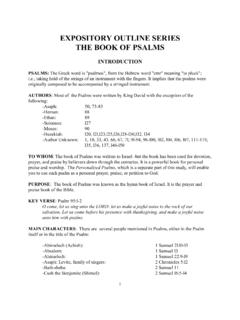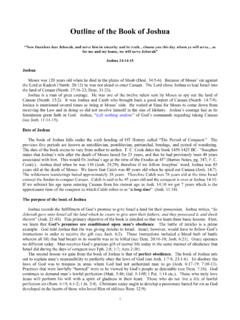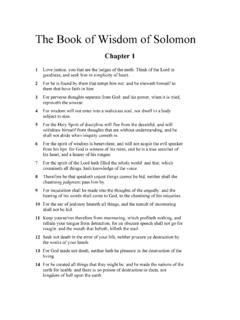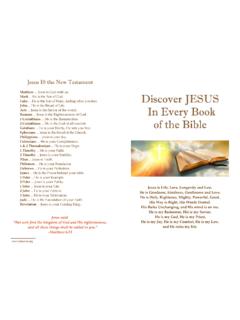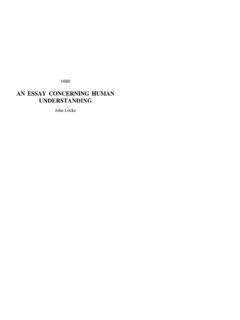Transcription of Gregory of Nyssa THE LIFE OF MOSES - NHI Home
1 Gregory of Nyssa THE life OF MOSES TRANSLATION. INTRODUCTION AND NOTES BY ABRAHAM J. MALHERBE AND EVERETT FERGUSON PREFACE BY JOHN MEYENDORFF PAULIST PRESS NEW YORK MAHWAH Cover Art: The artist WILLIAM RABINOVITCH is a painter and sculptor who since 1973 together with artist partner Arthur Guerra has directed the Rabinovitch and Guerra Gallery in New York City's SoHo. He has studied at the San Francisco Art Institute, Whitney Museum Program, Boston Museum School of Fine Arts and a number of European schools. He has exhibited at the Allan Stone Gallery in New York City and the Monterey Peninsula Museum of Art in Monterey, California; he has also had a one-man show at the Casa Americana in Madrid and other galleries.
2 In 1977 he was Project Director of the highly successful Whitney Counterweight, an artist-initiated museum-scale event held in dialogue with the Whimey Biennial. Of his cover painting he says: "The water color is meant to convey a stained glass effect in order to bring out the luminosity, fluidity, and intensity suggested by Saint Gregory 's life . I have worked in an expres sionistic style reminiscent of the highly expressive Greek icon and Mosaic art but reinterpreted in a twentieth century way so as to create a kind of aesthetic bridge with his time. The figure of Gregory conveys the degree of asceticism and necessary mystery he espoused as a correct way toward the path of enlightenment.
3 His serious bearded countenance was further suggested by an eleventh century miniature. To me, the triangle form beyond the halo conveys his strong sense of the Trinity and the unity of man. Another aspect of the triangle suggests its allusion to Mount Sinai and the idea that the achieving ofeach summit creates new horizons emphasizing Gregory 's idea that progress itself is perfection ." Note: The life of MOSES is published in cooperation with Cistercian Publications Inc., Kalamazoo, Michigan, and is Number 31 in their series, Cistercian Studies. Design: Barbini Pesce & Noble, Inc. Copyright 1978 by Paulist Press, Inc. All rights reserved. No part of this book may be reproduced or transmitted in any form or by any means, electronic or mechanical, including photocopying, recording or by any information storage and retrieval system without permission in writing from the Publisher.
4 Library of Congress Catalog Card Number: 78-56352 ISBN: 0-8091-2112-3 Published by Paulist Press 997 Macarthur Boulevard Mahwah, New Jersey 07430 Printed and bound in the United States of America CONTENTS Preface xi Foreword xvii Introduction 1 Text 25 Bibliography 139 Notes 141 Indexes 195 -vii- The Editors of this Volume: ABRAHAM J. MALHERBE is Professor of New Testament Studies at Yale Divinity School. After completing his Doctoral work at Harvard, he went on for further studies at the University of Utrecht before taking New Testament teaching positions at Abilene Christian College and Dartmouth College before coming to Yale in 1970.
5 His books include World of the New Testament, Social Aspects of Early Christianity and The Cynic Epistles: A Study Edition. some of the journals in which his articles have appeared include Journal of Biblical Literature, Journal of Ecclesiastical History, Restoration Quarterly, Journal of Theological Studies, and others. Professor Malherbe is on the Editorial Board of the Journal of Biblical Literature. Born in Pretoria, South Africa, he lives with his wife Phyllis and their three children in Hamden, Connecticut. EVERETT FERGUSON is Professor of Church History and Director of Graduate Studies in Religion at Abilene Christian University. After completing his doctoral work, "With Distinction," at Harvard, where he was a John Harvard Fellow, in 1957, he became Dean of Northeastern Christian Junior College, in Villanova, Pennsylvania.
6 His books include Early Christians Speak and his articles have appeared in Harvard Theological Review, Greek Orthodox Theological Review, Journal of Theological Studies, Studia Patristica and others. Dr. Ferguson was born in Montgomery, Texas. He lives in Abilene with his wife Nancy and their three children. JOHN MEYENDORFF is Professor of History, Fordham University and Professor of Patristics and Church History, St. Vladimir's Seminary, Tuckahoe, New York. Father Meyendorff is an internationally esteemed authority on Orthodox Spirituality. His books include St. Gregory Palamas and Orthodox Spirituality (1959), Gregory Palamas (1959), The Orthadox Church (1963), Orthodoxy and Catholicity (1966), Christ -viii- in Eastern Christian Thought (1969), Byzantine Theology (1974), and Byzantine Hesychasm (1974).
7 Dr. Meyendorff is presently on a research fellowship at the Dumbarton Oaks Center for Byzantine Studies, Washington, -ix- Acknowledgments It is with pleasure that we acknowledge our indebtedness to those who have had a special interest in our preparation of this volume. We undertook the task in response to a suggestion by Professor Johannes Quasten that a translation of Gregory 's Vita Moysis into English was long overdue. Professors George Williams and Milton Anastos have encouraged us in patristic studies. The libraries of Abilene Christian College and Harvard University always graciously acceded to our requests, trifling and audacious alike. Zelma Odle preserved us from the grossest inelegancies of language; only our obstinacy is responsible for those that remain.
8 Finally, we hope that the publication of this book may in some small way repay our families for the neglect it caused them. The manuscript was awarded a prize by the Christian Research Foundation in 1967. -x- Preface The Christian Church, by receiving freedom and favors from the Empire of Rome, was endowed with a new opportunity and new responsibilities. It was now in a position of addressing itself not only to the simple folk in a few major cities with its "Good News" of the coming Kingdom in the risen Lord Jesus, but the entire world of educated aristocrats and intellectuals, trained in the traditions of syncretic Hellenism, was now ready to listen. One of the major problems faced by Christianity in these new circumstances was that its Scriptures were Jewish Scriptures, that it claimed that Jesus was the Messiah foretold by Jewish prophets and that, therefore, the message of Jesus was not understandable except against the Old Testament background.
9 Now the Hellenistic mind could hardly be receptive to the religious history of the obscure "barbarian" -xi- nation of the Jews. The Greek philosophical tradition and, in particular, the mystagogical trends of Neo-Platonism were open to a syncretistic absorption of Oriental religions, but not to the absolute claims of the Mosaic or Christian faiths. At the time when Gregory of Nyssa was writing his life of MOSES , others had already tried to build a bridge between Hellenism and the Jewish Scriptures and, among them, particularly the Jew Philo and the Christian Origen. Gregory is indebted to them both. But his approach, as also that of the other two "Cappadocian Fathers" his elder brother Basil and his friend Gregory of Nazianzus more than that of his predecessors, was a witness to the Church.
10 Gregory and his friends were influential Christian bishops, concerned not only with intellectual pursuits or individual mysticism, but also with orthodox doctrine, with the Church as a sacramental body and as an institution, now closely connected with the Roman state. The major achievement of their lives was that they had succeeded in maintaining their commitments to the Church, to Scripture, and to the Hellenistic tradition, without compromise and with intellectual and spiritual integrity. The synthesis which they produced was not necessarily a perfect synthesis which was impossible because of their rejection of syncretism and their obvious prior and ultimate commitment to the Christian faith but their honesty and consistency won the respect of pagans and Christians alike.


